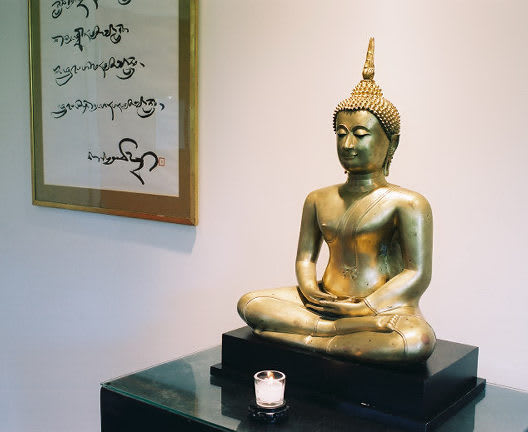Little changes that add up to enlightened society
Making enlightened society possible involves a lot of little steps that are not always visible until you take a bend in the path. For the past several months I’ve been working with two relatively invisible master-data-base-administrators in Shambhala, Bernard in Köln, Germany and Candlin Dobbs in St. Johnsbury, Vermont. We doing a demonstration project to link the Shambhala Database (that holds registration and membership records) with MailChimp (which we use to send out the weekly newsletter). The goal is to simplify how we manage email addresses: it’s no big deal in a way, but it’s a change and there are bound to be glitches. The subscribe and un-subscribe forms will change a bit. The main thing is that we won’t have to keep separate lists in synch. In the transition you might get email you don’t want or not get email that you do want. That got me to thinking about how many little experiments and changes have happened over the years that add up to a lot of change in our Shambhala Center.
Coincidentally, David Parker mentioned that he was the webmaster in 1999 when I moved to Portland and that he had learned to code HTML by hand to set up the Shambhala Center’s web page. Here’s what it looked like then next to what our website looks like today. Lots of little, little, little changes over the years have added up. (You can see what the old website looked like as of March 2000 and what programs were being offered here.)
 |
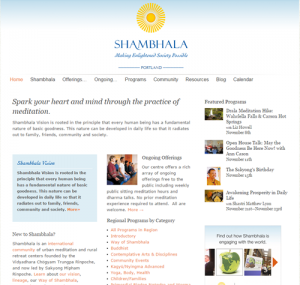 |
Now our website is much more sophisticated, but there still are little changes happening all the time. For example, David Engelbrecht and I are copying an idea from the Victoria Shambhala Center and inserting small photos of the teachers in all of our programs. When you are thinking of taking a class, you can see who’s going to be teaching it.
All this got me to thinking about what our Shambhala Center was like back then it first started. I asked a few people who were around here then. Jane Comerford (who did registration for Shambhala Training at that time) recalls:
When we first got to our present location (early 90’s), we had the front room, and [we kept] the shrine in a closet. We had to completely set up the shrine room every time we came to sit, and disassemble it after we finished! We only rented the space once a week, and that it was used by others during the rest of the time.
Here’s what Morgan Sidhe recalls about when there were 30 or 40 members (compared to today’s 115 members):
“We had a double shrine set up that was opposite today’s shrine [which is on the south wall]; we sat with our backs to the window and the Buddhist shrine was to the left, and the Shambhala shrine to the right. Our first Refuge Ceremony was held 15 yrs-ago, Nov. 1st, 1998, with Ashe Acharya John Rockwell as preceptor. Our main entrance to the shrine room today was a hall closet then, and we kept our tea there. The office of today was a Native American services provider, who posted a sign at the front door stating the building was “clean and sober.” We could get about 20 hours of practice in per month if you did not miss any sitting periods. I miss the old radiophone hookup on Shambhala Day, the echo effect made us sound like we were in outer-space.
“I was instrumental in getting the library going, and collected over 400 books during my tenure, and, thanks to David Parker, we got many of the new releases. Thanks David.”
I did a little digging in my photos and came across these two that show our shrine room when the shrine was on the north wall.
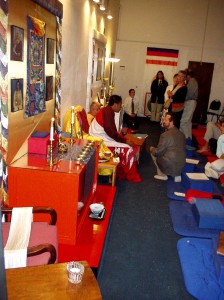 |
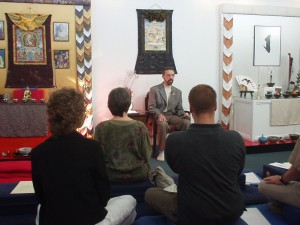 |
Jack Bodner identifies the photo on the left as being from an August 3, 2001 visit from Tulku Sang-Ngag Rinpoche, who gave talks on two evenings: “Lojong: Training the Mind” and “Stupas: The Body of Enlightenment.” The photo on the right shows Jack Bodner, who was the Center Director later on, sitting between the two shrines. One story I heard from about that time was that the sun coming in the south windows was so bright on the shrine and so concentrated by the crystal ball that one day it started a fire! After that our shrine had to do without a crystal ball until the shrine moved to the opposite wall. (A crystal ball represents the clarity and emptiness of mind). Sometime later the Sakyong unified the two shrines (Portland was one of the first Shambhala Centers to have the unified shrine, just in time for the Sakyong’s second visit).
 |
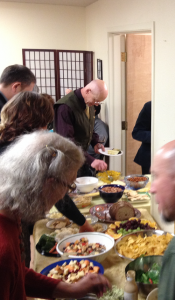 |
Although some things change, others don’t. For example, many years ago, our Center had a tradition of a pie-baking contest at the Fall Solstice Harvest of Peace event. That tradition has fallen away, but food and conversation are just as important. The photo on the left shows pies from from the contest in 2001 or so. It was hard to choose and being a judge was a primo job. On the right is a potluck in 2014 (desserts couldn’t fit on the same table).
 |
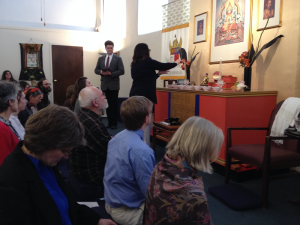 |
But back-room changes like the new slots for mail in the office (shown on the left) are part of our incremental evolution. On the right is a photo from Shambhala Day 2014, with Center Director Lisa Stanley lighting the candles. Notice that the crystal ball is now on the shrine and because it’s on the south wall it’s not in danger of setting anything on fire. Today the Sakyong’s Shambhala Day address is not a radiophone hookup with bizarre sound effects: it’s a streaming video feed (which still has the occasional glitch).
Another bit of history that I got from David Parker was his job description from the turn of the century. Although how we do them, so many of the tasks that needed to be done exist in similar form today. It’s just different people doing them and there are a lot more things to do for a larger and more diverse community to function. So the work is distributed and coordination is much more important. Not everybody will find this as fascinating as I do, but for those who do, here is the unexpurgated job description from David:
Comptroller (I would like to turn this over to someone else)
Responsible for all accounts and finances except Shambhala Training, which is separate and occasionally pays rent to the Center.
Paying out
- Bills: rent, honoraria and teacher’s gifts, travel, telephone, insurance (yearly), subscriptions, services, book purchases, etc.
- Reimbursing others: writing checks and obtaining receipts
- Cash for change at public events
Collecting
- Dues as checks or cash from mail or collection box or by hand (could be shared with Membership)
- Donations as checks or cash
- Class and program income and teacher’s gifts
- Rent from Rigpa, Shambhala Training
- Book sales
Keeping track
- Checkbook and cash account maintenance (Quicken), detailed categories, verifying checks written by others, saving receipts, relationship with bank
- Monthly reports to Council at Council meetings, cash flow outlook, approval for new or major expenses
- Quarterly reports to the community – where the money comes from and how it is spent
- Yearly reports to Vajradhatu (includes assets)
- Yearly lease agreement with the landlord
- Some kind of yearly internal audit needs to be set up
Membership Coordinator (I would like to do more of this)
Keeps track of members, new members, and potential new members – dues, opportunities to participate, connection with MI, and personal welfare
Dues
- Keeps track of dues paid and owed (could share collection and deposit of dues with Comptroller)
- Reminds members in arrears by phone or postcard
- Takes care of automatic funds transfers and receives funds transfer statements
- Promotes funds transfer and dues increases, in coordination with Fundraising
Membership
- Maintains Members and Friends list – keeps track of newcomer/new member boundary, member/friend boundary
- Promotes membership – at the center and in the newsletter
- Welcomes new members and answers questions about membership – notifies the Practice Coordinator about need for an MI
- Finds out about members’ interests and needs
- Individual suggestions to members about jobs and opportunities to participate
- Provides content on interests and participation to Mailing List database
Other jobs I am doing or have thought about doing
(I am willing to turn these over to others)
Webmaster
Bookstore
Newsletter calendar production
Audio/visual techie
Fundraising
Hospitality


